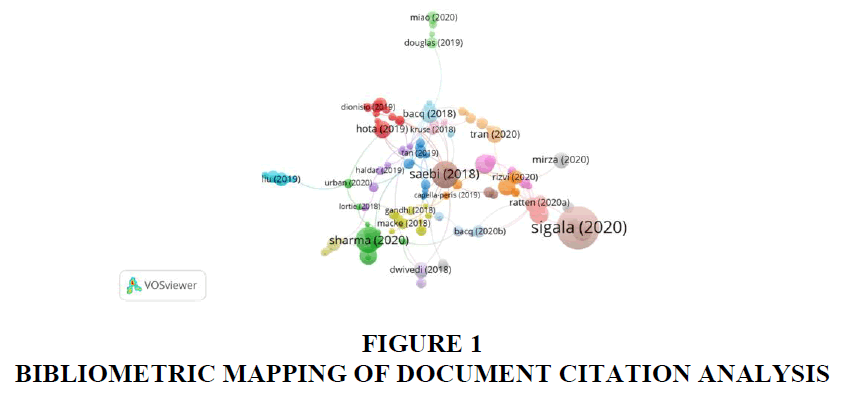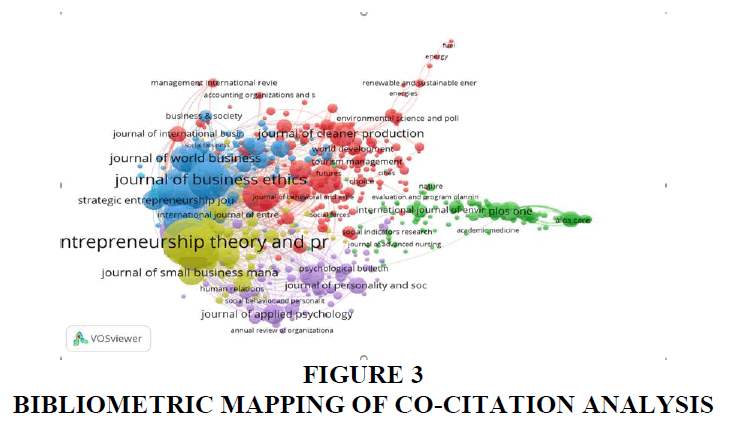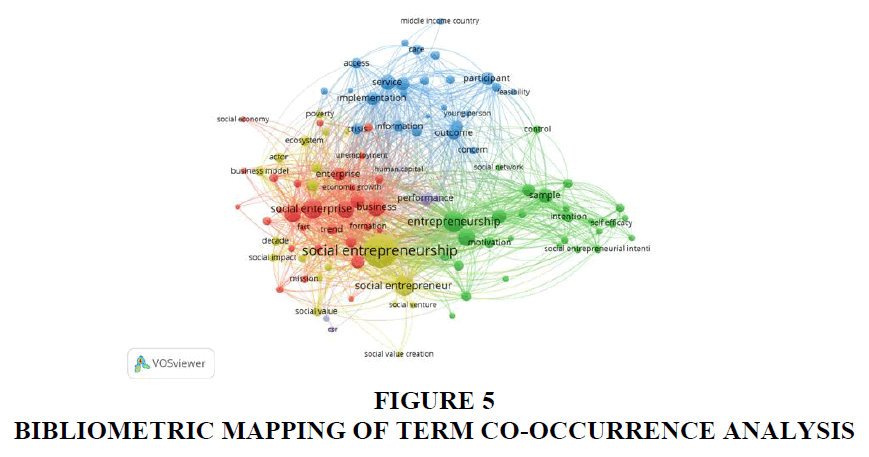Research Article: 2024 Vol: 28 Issue: 6
Social Entrepreneurship- A Systematic Review Approach through Bibliometric Analysis
Biju S K, Government College for Women, Thiruvananthapuram
Sajithkumar P, Government College, Manjeswaram, Kerala
Biju T, University of Kerala, Thiruvananthapuram
Vijayakumar V, Nehru Arts and Science College, Kanhangad
Citation Information: Biju, SK, Sajithkumar P, Biju T, & Vijayakumar, VK. (2024). Social entrepreneurship- a systematic review approach through bibliometric analysis. Academy of Marketing Studies Journal, 28(6), 1-7.
Abstract
Social entrepreneurship is a kind of entrepreneurship wherein entrepreneurial initiatives are undertaken with the intention of addressing social issues and devising novel and creative ways of tackling the social issues and suggest effective solutions to the social issues. The present study is carried out uncover the theoretical foundations and knowledge base of social entrepreneurship research for the past five years from 2018 to 2022 through a systematic review of literature approach. The data for the paper is obtained from the Dimensions data base and various bibliometric analysis techniques such as “citation, co-citation, bibliographic coupling and term co-occurrence analysis” is performed through Vosviewer software to find out the most influential works, authors, sources and terms with regard to social entrepreneurship literature.
Keywords
Social Entrepreneurship, Social Dilemmas, Social Enterprise, Social Problems, Social Entrepreneur.
Introduction
Social entrepreneurship is a phenomenon which tends to address social issues through application of entrepreneurial philosophies, principles and concepts that facilitate social change. (Roundy, 2017). It attempts to discover new ways of approaching the social issues and recommending effective solutions for the same. The very goal of social entrepreneurship is aimed at eliminating social problems through a comprehensive approach. Its evolution has led to the discovery of solutions to several burning social dilemmas. It discovers creative and effective solutions to the social problems (Welsh & Krueger, 2012). The social entrepreneurship model is shaped by the forces such as opportunity mobilization and transformation of the opportunities into reality as business units (Korsgaard, 2011).
The thoughts of social businessmen towards social entrepreneurship are influenced by his or her surrounding atmosphere and his mindset towards social issues. A person who is sensitive towards social issues is likely to address the same through his entrepreneurial efforts (Omorede, 2014). The success of the social entrepreneurs is the result of a congenial entrepreneurial eco-system. The entrepreneurial eco-system is described as a source which provides required resources, infrastructural support, unseized opportunities, etc. which drives social entrepreneurs to make an attempt of establishing ventures that emphasize social values (Roundy, 2017). The social entrepreneurship and public sector units found to be connected to a greater extent where both focus on producing enhanced values and welfare for the community (Gawell, 2014).
The outcomes anticipated from social entrepreneurial activities comprise of generating value for the society, fetching income, devising novel solutions to social issues, ensuring sustainability of social business ventures, etc. At this juncture, the current paper aims to present the theoretical background of the social entrepreneurship literature through a systematic review approach.
Review of Literature
The social entrepreneurship aims to generate social outcomes and impacts from the entrepreneurial activities intending sustainability of the business ventures (Ebrashi, 2013). The various dimensions of social entrepreneurship have different roles and different outcomes (Gawell, 2013). Social entrepreneurship initiatives are the guiding force for the generation of superior social value, social capital, and performance of the enterprises (Naderi et al., 2019). Social entrepreneurial initiatives in a country is influenced by numerous factors of political, cultural and economic nature (Fakoussa et al., 2020).
The factors that triggers peopactivities intending sustainability of the business ventures (Ebrashi, 2013). The various dimensions of social entrepreneurship have different roles and different outcomes (Gawell, 2013). Social entrepreneurship initiatives are the guiding force for the generation of superior social value, social capital, and performance of the enterprises (Naderi et al., 2019). Social entrepreneurial initle to enter into social entrepreneurship domain is the social conditions prevailing in the business atmosphere rather than the technology and allied aspects (Sooampon, 2018). The social entrepreneurs are driven by certain requisites such as willingness to bear high risk in carrying out entrepreneurial activities that address the social issues. They are interested in dealing the social issues in a novel manner. Besides they have great tenacity to cope with the inadequate institutional set up prevailing in the business environment. They are highly motivated by the problems and issues existing in the social set up and will be enthusiastic to find solutions to tackle the same (Ghalwash et al., 2017).
The personality characteristics of the individuals such as the ability to take decisions, human related skills, and the social networks favourably affect the entrepreneurial initiatives of social nature. The urge and capability of social entrepreneurs is the starting point for an individual to engage in these kinds of business activities. Besides, the social and institutional aspects in the business environment too have an effect on social entrepreneurship (Jiao, 2011). The social venture creation is affected by a large number of factors such as gender, education, role models in entrepreneurship, wealth status, unemployment, and the age of the budding entrepreneurs (Kachlami et al., 2018). Besides, Both the men and women social entrepreneurs possess same characteristics with regard to their course of action. The variation is found only in one dimension that is with regard to their agreeability in terms of social effect of their enterprise. Women social entrepreneurs found to be more cautious about the social outcomes of their business dealings (Bernardino et al., 2018).
The problems and difficulties encountered by the entrepreneurs at their personal level are the major driving force for them to involve in social entrepreneurship. Along with finding ways to resolve their personal issues a little emphasis is also given to the social problems (Goyal et al., 2016). Thus, this literature is found to be so rich with numerous studies undertaken in this field. The present paper tries to explore the theoretical foundations of social entrepreneurship literature through a systematic review approach.
Methodology
The study objective to ascertain the theoretical aspects of the social entrepreneurship literature is met by adopting a systematic review approach through bibliometric analysis. Various analysis techniques such as “citation analysis, co-citation analysis, bibliometric coupling network analysis and keyword co-occurrence analysis” is performed to ascertain the most influential works, contributors, terms and sources in the social entrepreneurship literature.
Bibliographic Data and analysis
The paper made use of bibliographic data on social entrepreneurship so as to extract the theoretical aspects of the topic. The data was obtained from the Dimensions database by employing the keyword “social entrepreneurship”. The search limited the type of publication to article and restricted to the period to five years from 2018 to 2022. The search fetched 11253 full data articles, however 2500 articles with highest citations sorted based on the relevance were selected for the study and the bibliographic data on the same are retrieved for the analysis.
The data obtained from the Dimensions data base were utilized for performing bibliometric analysis through VosViewer software. The tools such as “Citation, co-citation, bibliographic coupling and keyword co-occurrence analysis” were performed to find the most impactful works, authors, sources and terms in the field of social entrepreneurship.
Analysis and Discussions
Citation Analysis
It is performed to find out the significance of a work, author, institution etc., based on the number of times the particular work, author and institution etc. quoted by others. In the present paper the two kinds of citation analysis are carried out namely, document citation analysis and author citation analysis.
Document Citation Analysis
The analysis takes documents as unit of analysis. The minimum requirement of citation of a document for the analysis is fixed at 20 and it produced 347 documents meeting this condition. However, finally 151 documents which is found to be connected in the network formed the part of the analysis (Figure 1).
Table 1 depicts the most influential works in last five years in the field of social entrepreneurship based on the number of citations received by the same. It is evident from the table the article titled “Tourism and Covid-19: Impacts and implications for advancing and resetting industry and research” is the most impactful work with 1242 citations, followed by “Social entrepreneurship research: Past achievements and future promises” with 485 citations.
| Table 1 Document Citation Analysis | ||
| Title | Links | Citations |
| “Tourism and Covid-19: Impacts and implications for advancing and resetting industry and research” | 4 | 1242 |
| “Social entrepreneurship research: Past achievements and future promises” | 15 | 485 |
| “Reviving tourism industry post-covid-19: a resilience- based framework” | 2 | 448 |
| “Social entrepreneurship research: a review and future research agenda” | 3 | 252 |
| “Information technology solutions, challenges, and suggestions for tackling the covid-19 pandemic” | 1 | 243 |
Author Citation Analysis
It is employed to ascertain the most influential authors in social entrepreneurship research in the last five years. The analysis is performed by taking author as a unit of analysis, where minimum documents of an author expected is two and number of citations required fixed at 25. It generated 579 authors meeting these requirements. However, only 353 items went into final analysis as connection was spotted only between these items (Figure 2).
The analysis reveals the major contributors to the social entrepreneurship research in the last five years. From the table it is clear that Tang and Weiming are the most influential authors in the social entrepreneurship domain with 69 documents (Table 2).
| Table 2 Author Citation Analysis | ||
| Authors | Documents | Total Link Strength |
| 1. Tang, Weiming | 69 | 1681 |
| 2. Tucker, Joseph | 54 | 1372 |
| 3. Ratten, Vanessa | 11 | 21 |
| 4. Ramirez-montoya, Maria Soledad | 9 | 61 |
| 5. Teasdale, Simon | 9 | 53 |
Co-citation Analysis
It presents the relevance of the articles or sources based on the frequency at which it is cited by other pairs of works and sources. Here for the study, cited sources are taken as unit of analysis for the co-citation analysis. The minimum requirement for the citation of a source is kept at 25 and it produced 596 sources meeting this criterion (Figure 3).
The table 3 shows that journal “Entrepreneurship Theory and Practice” is most powerful source in publishing works in the field of social entrepreneurship for the last five years with total 3315 citations, followed by “Journal of Business Ethics” with 2183 citations.
| Table 3 Co-Citation Analysis | ||
| Journal | Citations | Total Link Strength |
| “Entrepreneurship Theory and Practice” | 3315 | 205863 |
| “Journal of Business Ethics” | 2183 | 132414 |
| “Academy of Management Review” | 1668 | 108036 |
| “Journal of Business Research” | 1566 | 97074 |
| “Sustainability” | 1170 | 54634 |
Bibliographic coupling network analysis
It represents the similar relationships between the documents. Coupling of works or authors happen at a time when two different works or authors cite a common third work. The analysis can be performed to ascertain the coupling between articles or authors. Here, coupling of authors is ascertained where minimum documents of an author is set at two and minimum citations required fixed at 25. It generated 379 authors meeting these requirements. However, 370 authors formed the part of final analysis (Figure 4).
The table 4 shows top five authors as per bibliographic coupling network analysis. The analysis reveals that Tang, weiming are the most coupled authors with 69 documents and 47402 total link strength.
| Table 4 Bibliographic Coupling Network Analysis | ||
| Authors | Documents | Total Link Strength |
| Tang, Weiming | 69 | 47402 |
| Ratten, Vanessa | 11 | 3600 |
| Wu, Yenchun Jim | 9 | 4112 |
| Erdmann, Alacoque Lorenzini | 7 | 3000 |
| Steiner, Artur | 7 | 2911 |
Term Co-occurrence Analysis
The objective of term co-occurrence analysis is to find the most frequently used terms in social entrepreneurship literature. For the analysis the terms from title and abstract field of the articles are retrieved. Here in the paper minimum occurrence of the term is fixed at 30 and it generated 435 terms meeting the condition. However, after elimination of irrelevant terms based on relevance score, 261 terms formed the part of final analysis (Figure 5).
Table 5 deals with the term co-occurrence analysis results. It shows the most frequently occurring five terms in social entrepreneurship literature for the last five years. “Social entrepreneurship” is the most frequently occurring term with 1113 co-occurrences.
| Table 5 Term Co-Occurrence Analysis | ||
| Terms | Occurrences | Total Link Strength |
| Social entrepreneurship | 1113 | 5757 |
| Entrepreneurship | 476 | 2745 |
| Social enterpreneur | 476 | 2745 |
| Social enterprise | 409 | 2546 |
| Concept | 313 | 1816 |
Conclusion
The present paper is undertaken to unravel the theoretical foundations of the social entrepreneurship research for the past five years by employing the bibliographic data regarding social entrepreneurship. The study made use of 2500 articles from 2018 to 2022 and undergone various bibliometric analysis techniques for the purpose of ascertaining the most influential work, author, source, coupled author and terms in the social entrepreneurship research.
The study revealed that “Tourism and Covid-19: Impacts and implications for advancing and resetting industry and research”, Tang and Weiming, “Entrepreneurship Theory and Practice”, Tang and Weiming and “Social entrepreneurship” are most influential article, author, source, coupled author and most frequently used terms respectively in the social entrepreneurship literature for the last five years. The study lay foundation for the upcoming researchers in this field to explore further in the social entrepreneurship.
References
Bernardino, S., Freitas Santos, J., & Cadima Ribeiro, J. (2018). Social entrepreneur and gender: what’s personality got to do with it? International Journal of Gender and Entrepreneurship, 10(1), 61–82.
Ebrashi, R. El. (2013). Social entrepreneurship theory and sustainable social impact. Social Responsibility Journal, 9(2), 188–209.
Indexed at, Google Scholar, Cross Ref
Fakoussa, R., O’Leary, S., & Salem, S. (2020). An exploratory study on social entrepreneurship in Egypt. Journal of Islamic Accounting and Business Research, 11(3), 694–707.
Indexed at, Google Scholar, Cross Ref
Gawell, M. (2013). Social entrepreneurship – innovative challengers or adjustable followers? Social Enterprise Journal, 9(2), 203–220.
Indexed at, Google Scholar, Cross Ref
Gawell, M. (2014). Social entrepreneurship and the negotiation of emerging social enterprise markets: Re-considerations in Swedish policy and practice. International Journal of Public Sector Management, 27(3), 251–266.
Ghalwash, S., Tolba, A., & Ismail, A. (2017). What motivates social entrepreneurs to start social ventures? Social Enterprise Journal, 13(3), 268–298.
Goyal, S., Sergi, B. S., & Jaiswal, M. P. (2016). Understanding the challenges and strategic actions of social entrepreneurship at base of the pyramid. Management Decision, 54(2), 418–440.
Indexed at, Google Scholar, Cross Ref
Jiao, H. (2011). A conceptual model for social entrepreneurship directed toward social impact on society. Social Enterprise Journal, 7(2), 130–149.
Indexed at, Google Scholar, Cross Ref
Kachlami, H., Yazdanfar, D., & Öhman, P. (2018). Regional demand and supply factors of social entrepreneurship. International Journal of Entrepreneurial Behaviour and Research, 24(3), 714–733.
Indexed at, Google Scholar, Cross Ref
Korsgaard, S. (2011). Opportunity formation in social entrepreneurship. Journal of Enterprising Communities, 5(4), 265–285.
Indexed at, Google Scholar, Cross Ref
Naderi, A., Nasrolahi Vosta, L., Ebrahimi, A., & Jalilvand, M. R. (2019). The contributions of social entrepreneurship and transformational leadership to performance: Insights from rural tourism in Iran. International Journal of Sociology and Social Policy, 39(9–10), 719–737.
Omorede, A. (2014). Exploration of motivational drivers towards social entrepreneurship. Social Enterprise Journal, 10(3), 239–267.
Indexed at, Google Scholar, Cross Ref
Roundy, P. T. (2017). Social entrepreneurship and entrepreneurial ecosystems Complementary or disjoint phenomena? International Journal of Social Economics, 44(9), 1252–1267.
Indexed at, Google Scholar, Cross Ref
Sooampon, S. (2018). The birth of social entrepreneurship within a Thai university. Journal of Asia Business Studies, 12(2), 162–172.
Indexed at, Google Scholar, Cross Ref
Welsh, D. H. B., & Krueger, N. (2012). The evolution of social entrepreneurship: what have we learned? Journal of Technology Management in China, 7(3), 270–290.
Indexed at, Google Scholar, Cross Ref
Received: 24-Jun-2024, Manuscript No. AMSJ-24-14956; Editor assigned: 25-Jun-2024, PreQC No. AMSJ-24-14956(PQ); Reviewed: 26-Jul-2024, QC No. AMSJ-24-14956; Revised: 26-Aug-2024, Manuscript No. AMSJ-24-14956(R); Published: 29-Sep-2024




